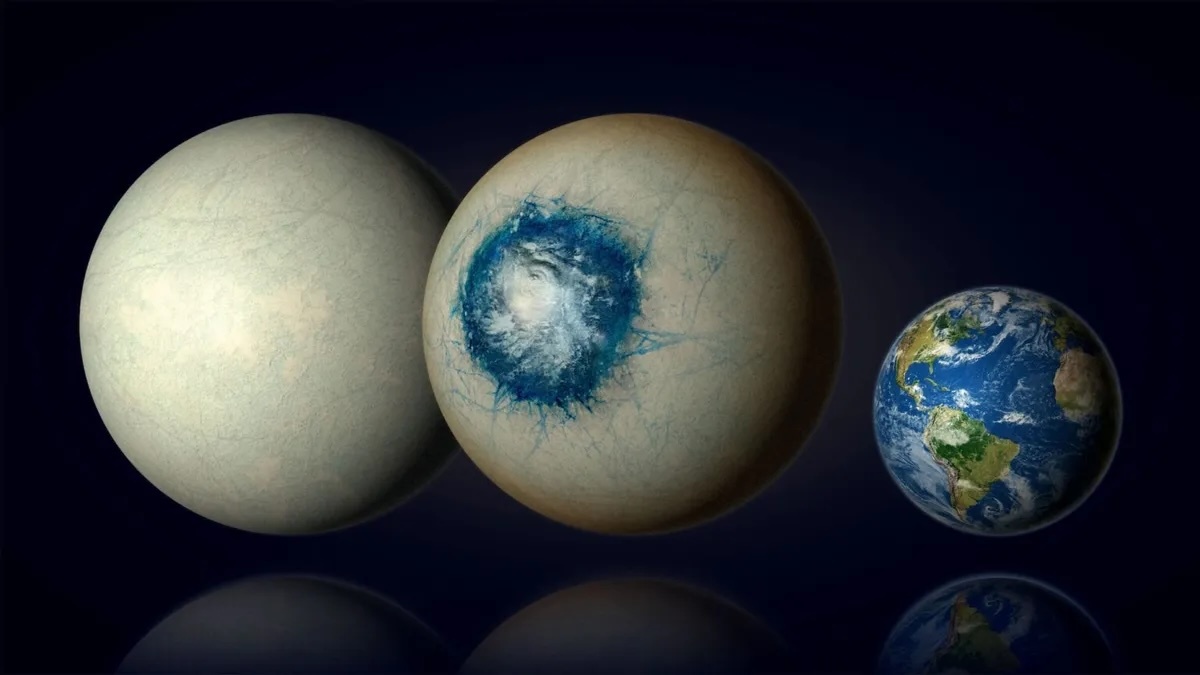The colors within this mid-infrared image reveal details about the central protostar’s behavior.
11.06.2024
WEBB TELESCOPE REVEALS ASTEROID COLLISION IN NEIGHBORING STAR SYSTEM
The observations spotlight the volatile processes that shape star systems like our own, offering a unique glimpse into the primordial stages of planetary formation
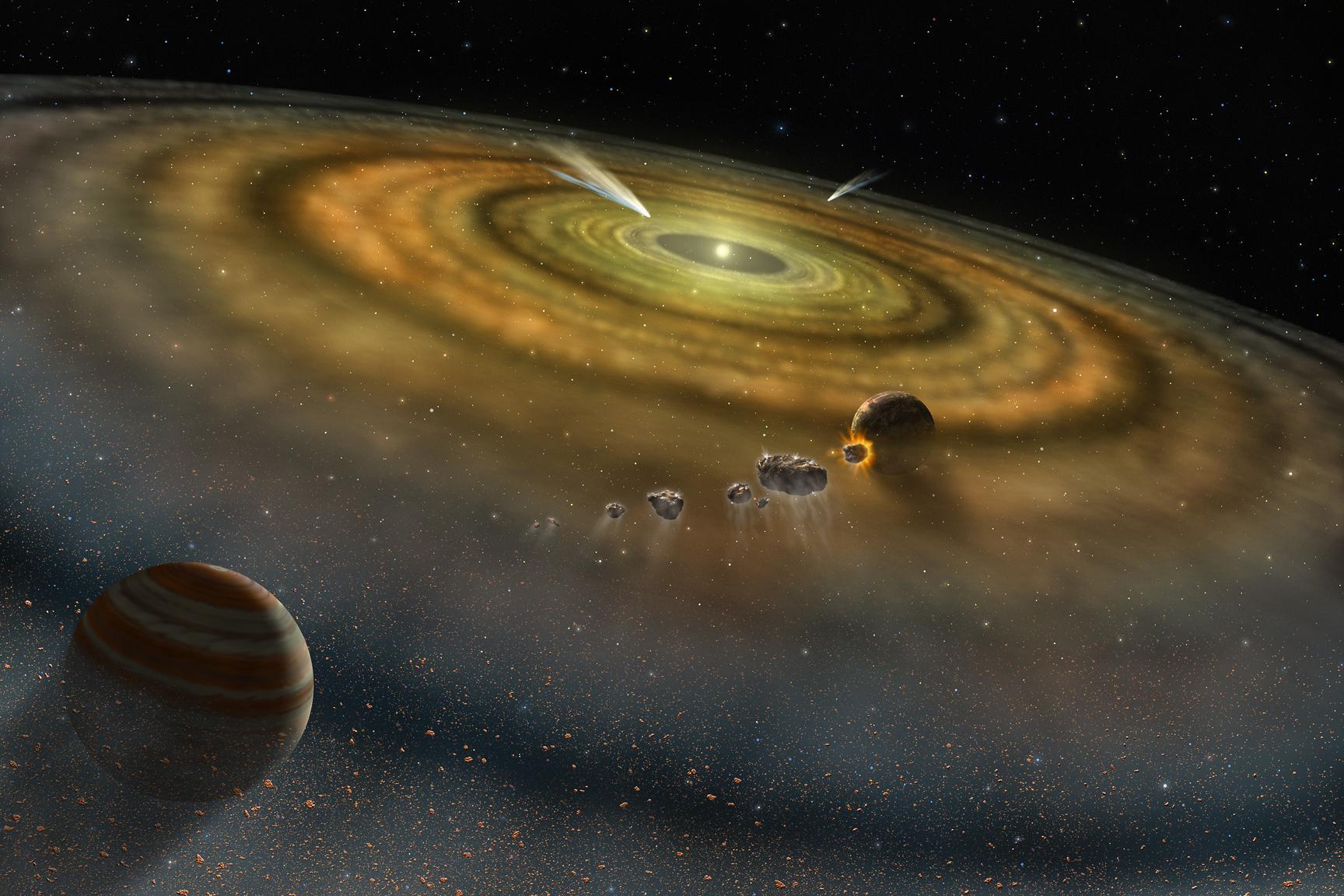
Astronomers have captured what appears to be a snapshot of a massive collision of giant asteroids in Beta Pictoris, a neighboring star system known for its early age and tumultuous planet-forming activity.
The observations spotlight the volatile processes that shape star systems like our own, offering a unique glimpse into the primordial stages of planetary formation.
"Beta Pictoris is at an age when planet formation in the terrestrial planet zone is still ongoing through giant asteroid collisions, so what we could be seeing here is basically how rocky planets and other bodies are forming in real time," said Christine Chen, a Johns Hopkins University astronomer who led the research.
The insights will be presented today at the 244th Meeting of the American Astronomical Society in Madison, Wisconsin.
Chen's team spotted significant changes in the energy signatures emitted by dust grains around Beta Pictoris by comparing new data from the James Webb Space Telescope with observations by the Spitzer Space Telescope from 2004 and 2005. With Webb's detailed measurements, the team tracked the dust particles' composition and size in the exact area previously analyzed by Spitzer.
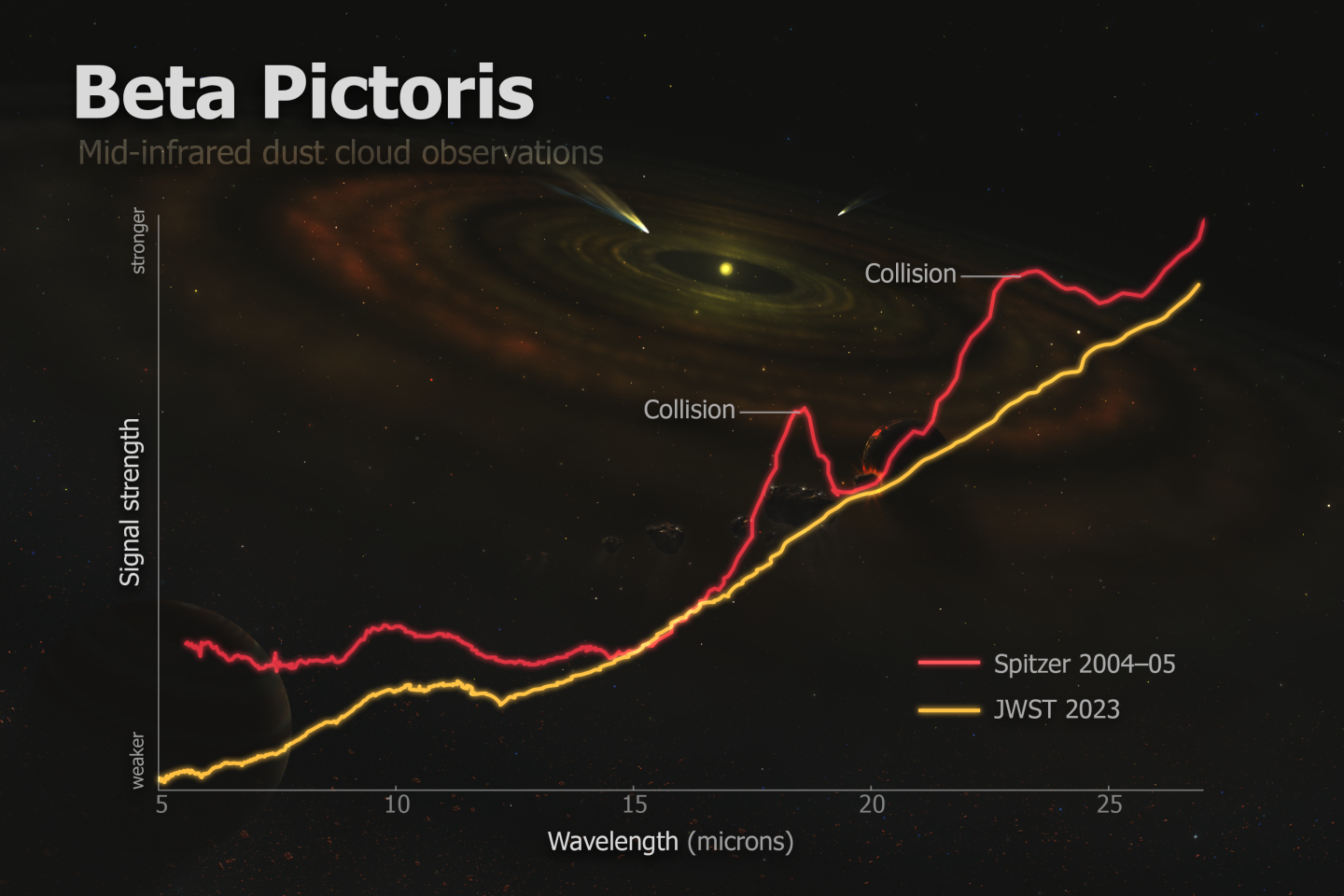
Image caption:Two different space telescopes took snapshots 20 years apart of the same area around the star called Beta Pictoris. Scientists theorize that the massive amount of dust seen in the 2004–05 image from the Spitzer Space Telescope indicates a collision of asteroids that had largely cleared by the time the James Webb Space Telescope captured its images in 2023.
IMAGE CREDIT: ROBERTO MOLAR CANDANOSA/JOHNS HOPKINS UNIVERSITY, WITH BETA PICTORIS CONCEPT ART BY LYNETTE COOK/NASA
Focusing on heat emitted by crystalline silicates—minerals commonly found around young stars as well as on Earth and other celestial bodies—the scientists found no traces of the particles previously seen in 2004–05. This suggests a cataclysmic collision occurred among asteroids and other objects about 20 years ago, pulverizing the bodies into fine dust particles smaller than pollen or powdered sugar, Chen said.
"We think all that dust is what we saw initially in the Spitzer data from 2004 and 2005," said Chen, who is also an astronomer at the Space Telescope Science Institute. "With Webb's new data, the best explanation we have is that, in fact, we witnessed the aftermath of an infrequent, cataclysmic event between large asteroid-size bodies, marking a complete change in our understanding of this star system."
The new data suggests dust that was dispersed outward by radiation from the system's central star is no longer detectable, Chen said. Initially, dust near the star heated up and emitted thermal radiation that Spitzer's instruments identified. Now, dust that cooled off as it moved far away from the star no longer emits those thermal features.
When Spitzer collected the earlier data, scientists assumed something like small bodies grinding down would stir and replenish the dust steadily over time. But Webb's new observations show the dust disappeared and was not replaced. The amount of dust kicked up is about 100,000 times the size of the asteroid that killed the dinosaurs, Chen said.
Beta Pictoris, located about 63 light years from Earth, has long been a focal point for astronomers because of its proximity and random processes where collisions, space weathering, and other planet-making factors will dictate the system's fate.
At only 20 million years—compared to our 4.5-billion-year-old solar system—Beta Pictoris is at a key age where giant planets have formed but terrestrial planets might still be developing. It has at least two known gas giants, Beta Pic b and c, which also influence the surrounding dust and debris.
"The question we are trying to contextualize is whether this whole process of terrestrial and giant planet formation is common or rare, and the even more basic question: Are planetary systems like the solar system that rare?" said co-author Kadin Worthen, a doctoral student in astrophysics at Johns Hopkins. "We're basically trying to understand how weird or average we are."
The new insights also underscore the unmatched capability of the Webb telescope to unveil the intricacies of exoplanets and star systems, the team reports. They offer key clues into how the architectures of other solar systems resemble ours and will likely deepen scientists' understanding of how early turmoil influences planets' atmospheres, water content, and other key aspects of habitability.
"Most discoveries by JWST come from things the telescope has detected directly," said co-author Cicero Lu, a former Johns Hopkins doctoral student in astrophysics. "In this case, the story is a little different because our results come from what JWST did not see."
Other authors are Yiwei Chai and Alexis Li of Johns Hopkins; David R. Law, B.A. Sargent, G.C. Sloan, Julien H. Girard, Dean C. Hines, Marshall Perrin and Laurent Pueyo of the Space Telescope Science Institute; Carey M. Lisse of the Johns Hopkins University Applied Physics Laboratory; Dan M. Watson of the University of Rochester; Jens Kammerer of the European Southern Observatory; Isabel Rebollido of the European Space Agency; and Christopher Stark of NASA Goddard Space Flight Center.
The research was supported by the National Aeronautics and Space Administration under Grant No. 80NSSC22K1752.
Quelle: Johns Hopkins University
----
Update: 18.06.2024
.
NASA's Webb Reveals Supernovae in the Early Universe
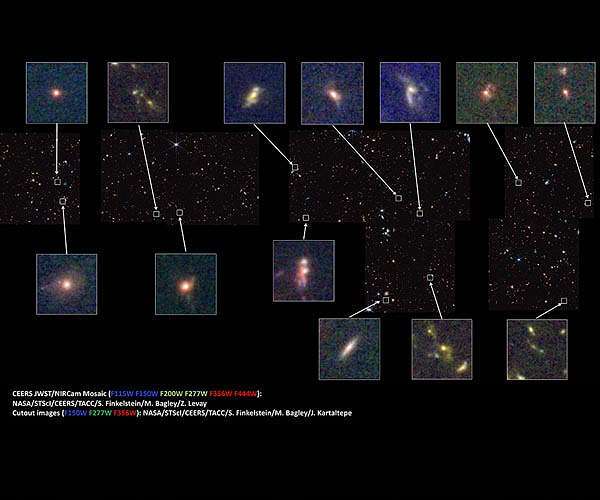
Peering deeply into the cosmos, NASA's James Webb Space Telescope is giving scientists their first detailed glimpse of supernovae from a time when our universe was just a small fraction of its current age. A team using Webb data has identified 10 times more supernovae in the early universe than were previously known. A few of the newfound exploding stars are the most distant examples of their type, including those used to measure the universe's expansion rate.
"Webb is a supernova discovery machine," said Christa DeCoursey, a third-year graduate student at the Steward Observatory and the University of Arizona in Tucson. "The sheer number of detections plus the great distances to these supernovae are the two most exciting outcomes from our survey."
DeCoursey presented these findings in a press conference at the 244th meeting of the American Astronomical Society in Madison, Wisconsin.
To make these discoveries, the team analyzed imaging data obtained as part of the JWST Advanced Deep Extragalactic Survey (JADES) program. Webb is ideal for finding extremely distant supernovae because their light is stretched into longer wavelengths - a phenomenon known as cosmological redshift.
Prior to Webb's launch, only a handful of supernovae had been found above a redshift of 2, which corresponds to when the universe was only 3.3 billion years old - just 25% of its current age. The JADES sample contains many supernovae that exploded even further in the past, when the universe was less than 2 billion years old.
Previously, researchers used NASA's Hubble Space Telescope to view supernovae from when the universe was in the "young adult" stage. With JADES, scientists are seeing supernovae when the universe was in its "teens" or "pre-teens." In the future, they hope to look back to the "toddler" or "infant" phase of the universe.
To discover the supernovae, the team compared multiple images taken up to one year apart and looked for sources that disappeared or appeared in those images. These objects that vary in observed brightness over time are called transients, and supernovae are a type of transient. In all, the JADES Transient Survey Sample team uncovered about 80 supernovae in a patch of sky only about the thickness of a grain of rice held at arm's length.
"This is really our first sample of what the high-redshift universe looks like for transient science," said teammate Justin Pierel, a NASA Einstein Fellow at the Space Telescope Science Institute (STScI) in Baltimore, Maryland. "We are trying to identify whether distant supernovae are fundamentally different from or very much like what we see in the nearby universe."
Pierel and other STScI researchers provided expert analysis to determine which transients were actually supernovae and which were not, because often they looked very similar.
The team identified a number of high-redshift supernovae, including the farthest one ever spectroscopically confirmed, at a redshift of 3.6. Its progenitor star exploded when the universe was only 1.8 billion years old. It is a so-called core-collapse supernova, an explosion of a massive star.
Of particular interest to astrophysicists are Type Ia supernovae. These exploding stars are so predictably bright that they are used to measure far-off cosmic distances and help scientists to calculate the universe's expansion rate. The team identified at least one Type Ia supernova at a redshift of 2.9. The light from this explosion began traveling to us 11.5 billion years ago when the universe was just 2.3 billion years old. The previous distance record for a spectroscopically confirmed Type Ia supernova was a redshift of 1.95, when the universe was 3.4 billion years old.
Scientists are eager to analyze Type Ia supernovae at high redshifts to see if they all have the same intrinsic brightness, regardless of distance. This is critically important, because if their brightness varies with redshift, they would not be reliable markers for measuring the expansion rate of the universe.
Pierel analyzed this Type Ia supernova found at redshift 2.9 to determine if its intrinsic brightness was different than expected. While this is just the first such object, the results indicate no evidence that Type Ia brightness changes with redshift. More data is needed, but for now, Type Ia supernova-based theories about the universe's expansion rate and its ultimate fate remain intact. Pierel also presented his findings at the 244th meeting of the American Astronomical Society.
The early universe was a very different place with extreme environments. Scientists expect to see ancient supernovae that come from stars that contain far fewer heavy chemical elements than stars like our Sun. Comparing these supernovae with those in the local universe will help astrophysicists understand star formation and supernova explosion mechanisms at these early times.
"We're essentially opening a new window on the transient universe," said STScI Fellow Matthew Siebert, who is leading the spectroscopic analysis of the JADES supernovae. "Historically, whenever we've done that, we've found extremely exciting things - things that we didn't expect."
"Because Webb is so sensitive, it's finding supernovae and other transients almost everywhere it's pointed," said JADES team member Eiichi Egami, a research professor at the University of Arizona in Tucson. "This is the first significant step toward more extensive surveys of supernovae with Webb."
Quelle: SD
----
Update: 26.06.2024
.
Webb captures star clusters in Cosmic Gems arc

An international team of astronomers have used the NASA/ESA/CSA James Webb Space Telescope to discover gravitationally bound star clusters when the Universe was 460 million years old. This is the first discovery of star clusters in an infant galaxy less than 500 million years after the Big Bang.

Young galaxies in the early Universe underwent significant burst phases of star formation, generating substantial amounts of powerful ultraviolet light. However, because of how far away they are from Earth, studying how many stars they contain has proven challenging.
Using Webb, an international team of astronomers have now detected five young massive star clusters in the Cosmic Gems arc (SPT0615-JD1), a strongly-lensed galaxy emitting light when the Universe was roughly 460 million years old, looking back across 97% of cosmic time.
The Cosmic Gems arc was initially discovered in NASA/ESA Hubble Space Telescope images obtained by the RELICS (Reionization Lensing Cluster Survey) programme of the lensing galaxy cluster SPT-CL J0615−5746.
“These galaxies are thought to be a prime source of the intense radiation that reionised the early Universe,” shared lead author Angela Adamo of Stockholm University and the Oskar Klein Centre in Sweden. “What is special about the Cosmic Gems arc is that thanks to gravitational lensing we can actually resolve the galaxy down to parsec scales!”
With Webb, the science team can now see where stars formed and how they are distributed, in a similar way to how the Hubble Space Telescope is used to study local galaxies. Webb’s view provides a unique opportunity to study star formation and the inner workings of infant galaxies at such an unprecedented distance.

“Webb's incredible sensitivity and angular resolution at near-infrared wavelengths, combined with gravitational lensing provided by the massive foreground galaxy cluster, enabled this discovery,” explained Larry Bradley of the Space Telescope Science Institute and PI of the Webb observing programme that captured these data. “No other telescope could have made this discovery.”
“The surprise and astonishment was incredible when we opened the Webb images for the first time,” added Angela. “We saw a little chain of bright dots, mirrored from one side to the other – these cosmic gems are star clusters! Without Webb we would not have known we were looking at star clusters in such a young galaxy!”
In our Milky Way we see ancient globular clusters of stars, which are bound by gravity and have survived for billions of years. These are old relics of intense star formation in the early Universe, but it is not well understood where and when these clusters formed. The detection of massive young star clusters in the Cosmic Gems arc provides us with an excellent view of the early stages of a process that may go on to form globular clusters.
The newly detected clusters in the arc are massive, dense and located in a very small region of their galaxy, but they also contribute the majority of the ultraviolet light coming from their host galaxy. The clusters are significantly denser than nearby star clusters. This discovery will help scientists to better understand how infant galaxies formed their stars and where globular clusters formed.

The team notes that this discovery connects a variety of scientific fields. “These results provide direct evidence that indicates proto-globular clusters formed in faint galaxies during the reionisation era, which contributes to our understanding of how these galaxies have succeeded in reionising the Universe,” explained Angela.
This discovery helps the astronomers to better understand how globular clusters formed and in what kind of conditions. "For instance, the high stellar densities found in the clusters provide us with the first indication of the processes taking place in their interiors, giving new insights into the possible formation of very massive stars and black hole seeds, which are both important for galaxy evolution,” added Angela.
In the future, the team hopes to observe many more galaxies in similar detail. “I am confident there are other systems like this waiting to be uncovered in the early Universe, enabling us to further our understanding of early galaxies,” said Eros Vanzella from the National Institute for Astrophysics (INAF) in Bologna, Italy, one of the main contributors to the work.
In the meantime, the team is preparing for further observations and spectroscopy with Webb. “We plan to study this galaxy with Webb’s NIRSpec and MIRI instruments in Cycle 3,” added Larry. “The NIRSpec observations will allow us to confirm the redshift of the galaxy and to study the ultraviolet emission of the star clusters, which will be used to study their physical properties in more detail. The MIRI observations will allow us to study the properties of ionised gas." The spectroscopic observations will also allow the team to map how active the sites of star formation are.
These results have been published today in Nature. The data for this result were captured under Webb observing programme #4212 (PI: L. Bradley).
Quelle: ESA
----
Update: 4.07.2024
.
NASA’s Webb Captures Celestial Fireworks Around Forming Star
The cosmos seems to come alive with a crackling explosion of pyrotechnics in this new image from NASA’s James Webb Space Telescope. Taken with Webb’s MIRI (Mid-Infrared Instrument), this fiery hourglass marks the scene of a very young object in the process of becoming a star. A central protostar grows in the neck of the hourglass, accumulating material from a thin protoplanetary disk, seen edge-on as a dark line.
The protostar, a relatively young object of about 100,000 years, is still surrounded by its parent molecular cloud, or large region of gas and dust. Webb’s previous observation of L1527, with NIRCam (Near-Infrared Camera), allowed us to peer into this region and revealed this molecular cloud and protostar in opaque, vibrant colors.
Image A: L1527 - Webb/MIRI
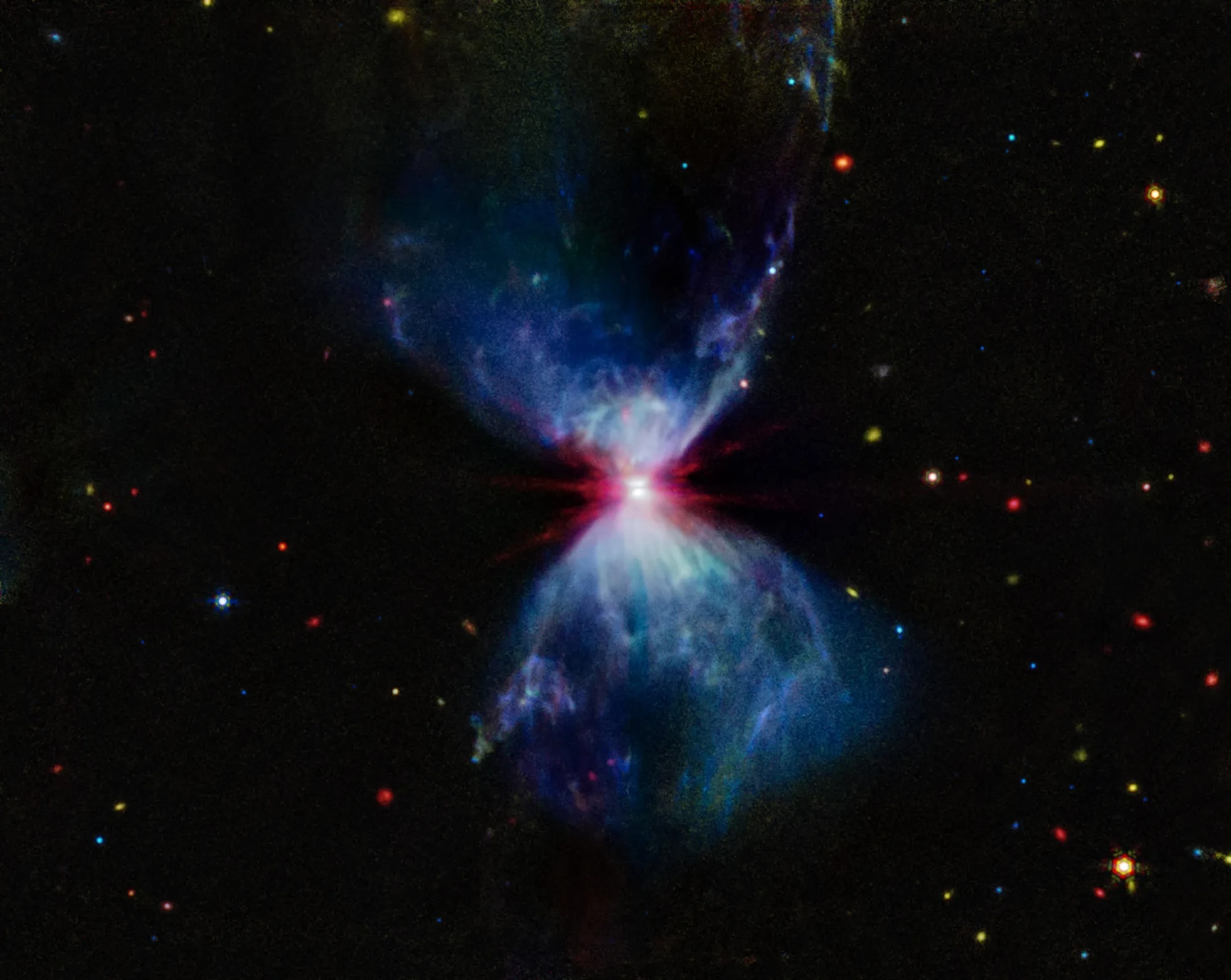
Both NIRCam and MIRI show the effects of outflows, which are emitted in opposite directions along the protostar’s rotation axis as the object consumes gas and dust from the surrounding cloud. These outflows take the form of bow shocks to the surrounding molecular cloud, which appear as filamentary structures throughout. They are also responsible for carving the bright hourglass structure within the molecular cloud as they energize, or excite, the surrounding matter and cause the regions above and below it to glow. This creates an effect reminiscent of fireworks brightening a cloudy night sky. Unlike NIRCam, however, which mostly shows the light that is reflected off dust, MIRI provides a look into how these outflows affect the region’s thickest dust and gases.
The areas colored here in blue, which encompass most of the hourglass, show mostly carbonaceous molecules known as polycyclic aromatic hydrocarbons. The protostar itself and the dense blanket of dust and a mixture of gases that surround it are represented in red. (The sparkler-like red extensions are an artifact of the telescopes’s optics). In between, MIRI reveals a white region directly above and below the protostar, which doesn’t show as strongly in the NIRCam view. This region is a mixture of hydrocarbons, ionized neon, and thick dust, which shows that the protostar propels this matter quite far away from it as it messily consumes material from its disk.
As the protostar continues to age and release energetic jets, it’ll consume, destroy, and push away much of this molecular cloud, and many of the structures we see here will begin to fade. Eventually, once it finishes gathering mass, this impressive display will end, and the star itself will become more apparent, even to our visible-light telescopes.
The combination of analyses from both the near-infrared and mid-infrared views reveal the overall behavior of this system, including how the central protostar is affecting the surrounding region. Other stars in Taurus, the star-forming region where L1527 resides, are forming just like this, which could lead to other molecular clouds being disrupted and either preventing new stars from forming or catalyzing their development.The James Webb Space Telescope is the world’s premier space science observatory. Webb is solving mysteries in our solar system, looking beyond to distant worlds around other stars, and probing the mysterious structures and origins of our universe and our place in it. Webb is an international program led by NASA with its partners, ESA (European Space Agency) and CSA (Canadian Space Agency).
The James Webb Space Telescope is the world's premier space science observatory. Webb is solving mysteries in our solar system, looking beyond to distant worlds around other stars, and probing the mysterious structures and origins of our universe and our place in it. Webb is an international program led by NASA with its partners, ESA (European Space Agency) and CSA (Canadian Space Agency).
THE JAMES WEBB SPACE TELESCOPE CAPTURES A STAGGERING QUASAR-GALAXY MERGER IN THE REMOTE UNIVERSE
Rome, – An international research group led by the Italian National Institute for Astrophysics (INAF) and comprising 34 research institutes and universities worldwide utilised the Near-Infrared Spectrograph (NIRSpec) on board the James Webb Space Telescope (JWST) to witness the dramatic interaction between a quasar inside the PJ308–21 system and two massive satellite galaxies in the distant universe. The observations, made in September 2022, unveiled unprecedented and awe-inspiring details, providing new insights into the growth of galaxies in the early universe. The results, presented today during the 2024 European Astronomical Society (EAS) meeting in Padua (Italy), will be published soon in Astronomy & Astrophysics.
Observations of this quasar (already described by the same authors in another study published last May), one of the first studied with NIRSpec when the universe was less than a billion years old (redshift z = 6.2342), have revealed data of sensational quality: the instrument “captured” the quasar’s spectrum with an uncertainty of less than 1% per pixel. The host galaxy of PJ308–21 shows high metallicity and photoionisation conditions typical of an active galactic nucleus (AGN), whereas one of the satellite galaxies exhibits low metallicity (which refers to the abundance of chemical elements heavier than hydrogen and helium) and photoionisation induced by star formation; a higher metallicity characterises the second satellite galaxy, which is partially photoionised by the quasar.
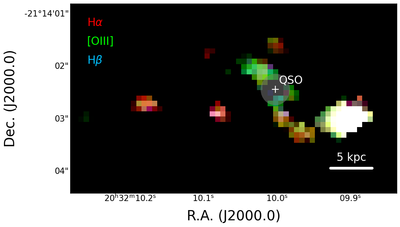
| Map of the line emission of hydrogen (in red and blue) and oxygen (in green) in the PJ308-21 system, shown after masking the light from the central quasar ("QSO"). The different colours of the quasar's host galaxy and companion galaxies in this map reveal the physical properties of the gas within them. Credits: Decarli/INAF/A&A 2024 |
The discovery has enabled astronomers to determine the mass of the supermassive black hole at the centre of the system (about 2 billion solar masses). It also confirmed that both the quasar and the surrounding galaxies are highly evolved in mass and metal enrichment, and in constant growth. This has profound implications for our understanding of cosmic history and galaxies' chemical evolution, highlighting this research's transformative impact.
Roberto Decarli, a researcher at INAF in Bologna and first author of the article, explains: "Our study reveals that both the black holes at the centre of high-redshift quasars and the galaxies that host them undergo extremely efficient and tumultuous growth already in the first billion years of cosmic history, aided by the rich galactic environment in which these sources form". The data were obtained in September 2022 as part of Program 1554, one of the nine Italian-led projects of the first observation cycle of JWST. Decarli leads this program to observe the merger between the galaxy hosting the quasar (PJ308-21) and two of its satellite galaxies.
The observations were carried out in integral field spectroscopy mode: for each image pixel, the spectrum of the entire optical band (in the source rest frame) can be observed, shifted towards the infrared by the universe’s expansion. This allows for the study of various gas tracers (emission lines) using a 3D approach. Thanks to this technique, the team led by INAF detected spatially extended emissions from different elements, which were used to study the properties of the ionised interstellar medium, including the source and hardness of the photoionising radiation field, metallicity, dust obscuration, electron density and temperature, and star formation rate. Furthermore, the researchers marginally detected the starlight emission associated with companion sources.
Federica Loiacono, astrophysicist, research fellow and postdoc working at INAF, enthusiastically comments on the results: "Thanks to NIRSpec, for the first time we can study in the PJ308-21 system the optical band, rich in precious diagnostic data on properties of the gas near the black hole in the galaxy hosting the quasar and in the surrounding galaxies. We can see, for example, the emission of hydrogen atoms and compare it with the chemical elements produced by the stars to establish how rich the gas in galaxies is in metals. The experience in reducing and calibrating these data, some of the first collected with NIRSpec in integral field spectroscopy mode, has ensured a strategic advantage for the Italian community in managing similar data from other programs". Federica Loiacono is the Italian contact person for NIRSpec data reduction at the INAF JWST Support Center.
She adds: “Thanks to the sensitivity of the James Webb Space Telescope in the near and medium infrared, it was possible to study the spectrum of the quasar and companion galaxies with unprecedented precision in the distant universe. Only the excellent 'view' offered by JWST, with its unparalleled capabilities, can ensure these observations". The work represented a real "emotional rollercoaster", Decarli continues, "with the need to develop innovative solutions to overcome the initial difficulties in data reduction".
This transformative impact of the James Webb Space Telescope's onboard instruments underscores its crucial role in advancing astrophysical research: “Until a couple of years ago, data on the enrichment of metals (essential for understanding the chemical evolution of galaxies) were almost beyond our reach, especially at these distances. Now we can map them in detail with just a few hours of observation, even in galaxies observed when the universe was in its infancy", Decarli concludes.
Quelle: INAF
----
Update: 10.07.2024
.
James Webb Space Telescope suggests this exoplanet is our 'best bet' at finding an alien ocean


